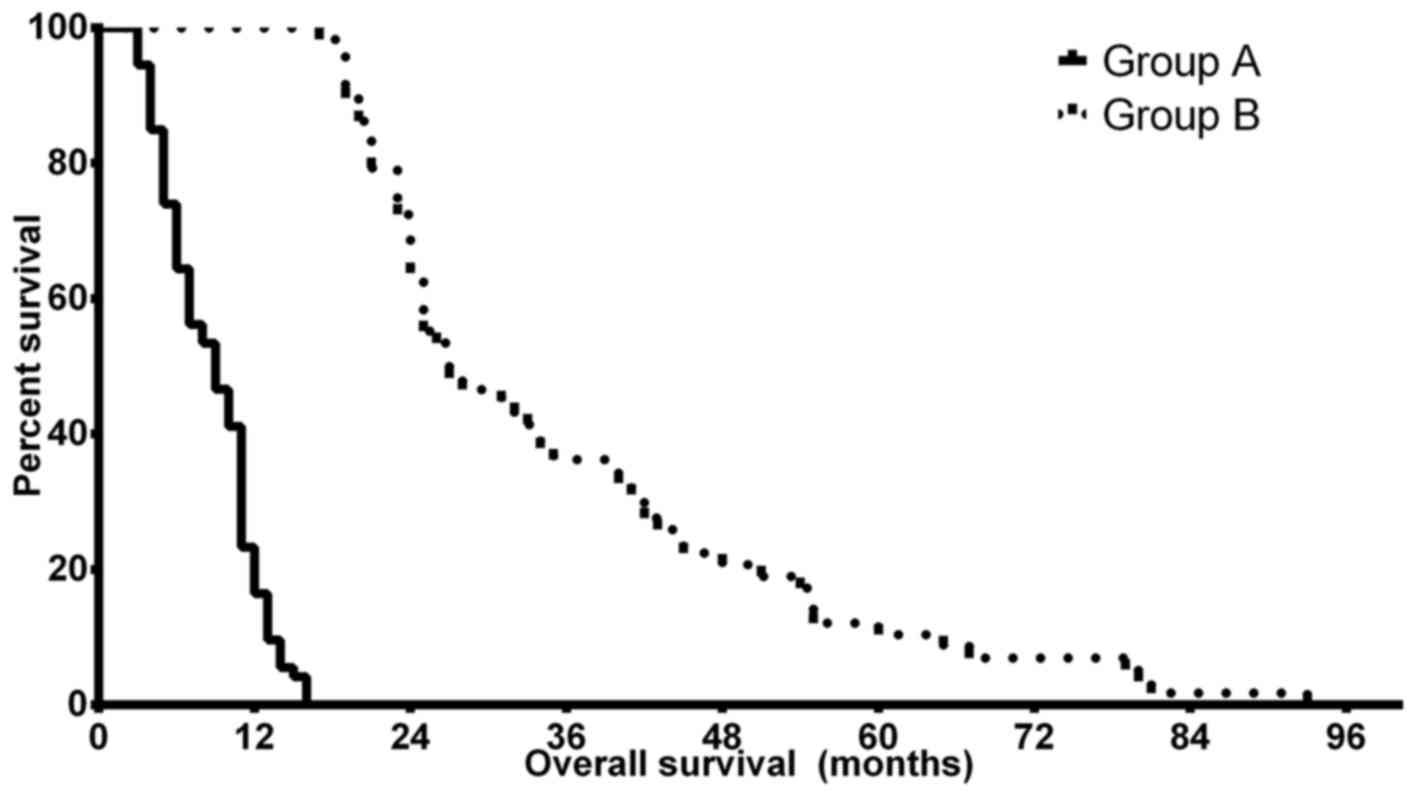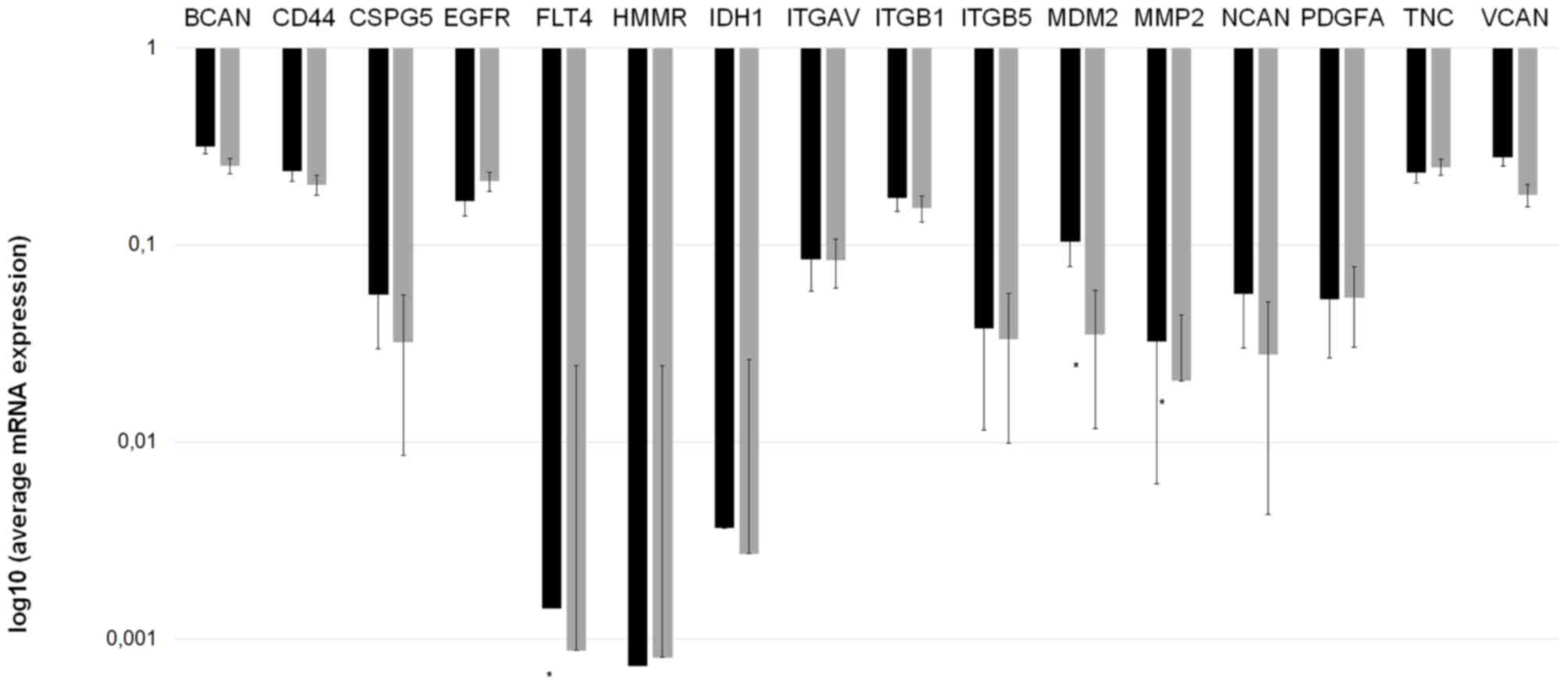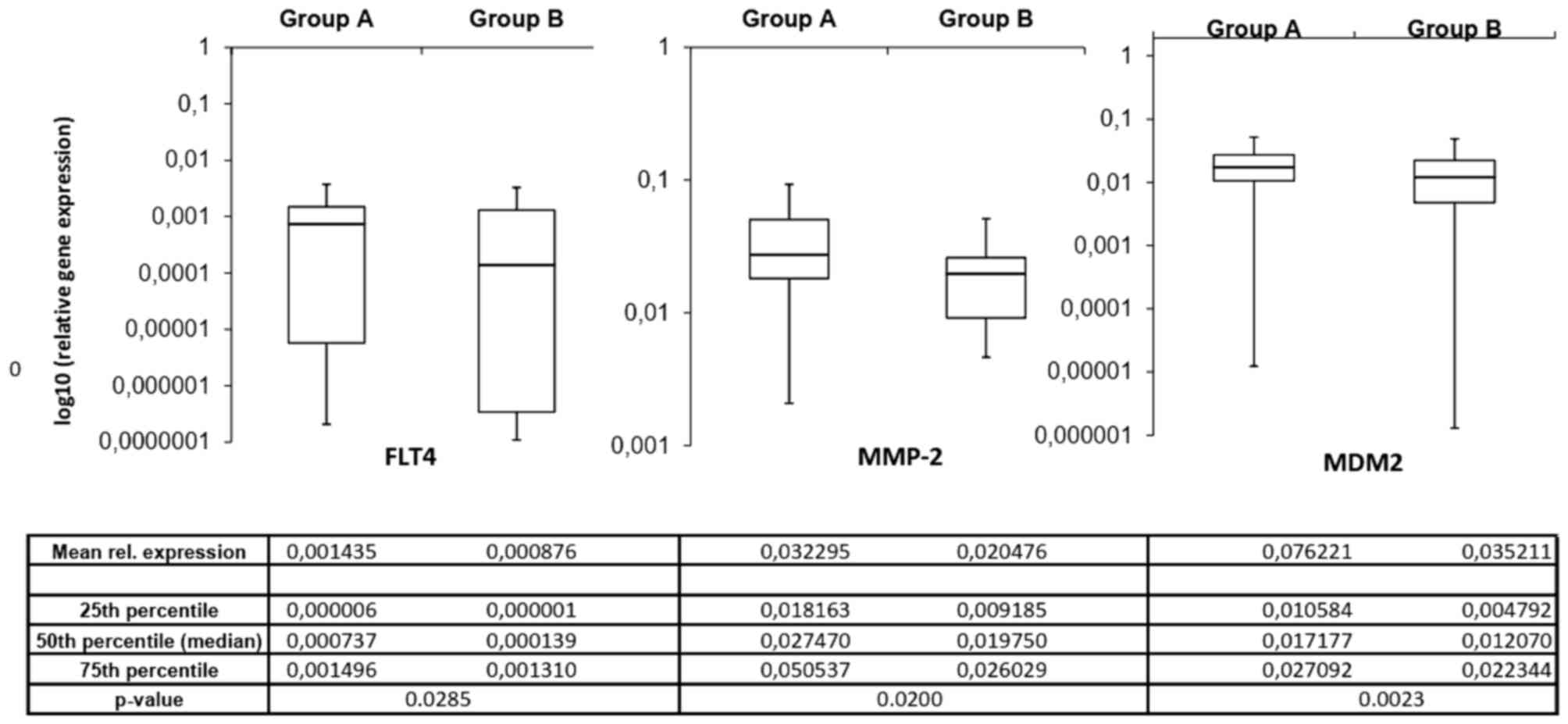|
1
|
Grossman SA, Ye X, Piantadosi S, Desideri
S, Nabors LB, Rosenfeld M and Fisher J; NABTT CNS Consortium, .
Survival of patients with newly diagnosed glioblastoma treated with
radiation and temozolomide in research studies in the United
States. Clin Cancer Res. 16:2443–2449. 2010. View Article : Google Scholar : PubMed/NCBI
|
|
2
|
Back MF, Ang ELL, Ng WH, See SJ, Lim CCT,
Chan SP and Yeo TT: Improved median survival for glioblastoma
multiforme following introduction of adjuvant temozolomide
chemotherapy. Ann Acad Med Singapore. 36:338–342. 2007.PubMed/NCBI
|
|
3
|
Chamberlain MC: Bevacizumab for the
treatment of recurrent glioblastoma. Clin Med Insights Oncol.
5:117–129. 2011. View Article : Google Scholar : PubMed/NCBI
|
|
4
|
Stupp R, Mason WP, van den Bent MJ, Weller
M, Fisher B, Taphoorn MJ, Belanger K, Brandes AA, Marosi C, Bogdahn
U, et al: Radiotherapy plus concomitant and adjuvant temozolomide
for glioblastoma. N Engl J Med. 352:987–996. 2005. View Article : Google Scholar : PubMed/NCBI
|
|
5
|
Krex D, Klink B, Hartmann C, von Deimling
A, Pietsch T, Simon M, Sabel M, Steinbach JP, Heese O, Reifenberger
G, et al: Long-term survival with gliossblastoma multiforme. Brain.
130:2596–606. 2007. View Article : Google Scholar : PubMed/NCBI
|
|
6
|
Donato V, Papaleo A, Castrichino A,
Banelli E, Giangaspero F, Salvati M and Delfini R: Prognostic
implication of clinical and pathologic features in patients with
glioblastoma multiforme treated with concomitant radiation plus
temozolomide. Tumori. 93:248–256. 2007. View Article : Google Scholar : PubMed/NCBI
|
|
7
|
Sanai N and Berger MS: Glioma extent of
resection and its impact on patient outcome. Neurosurgery.
62:753–764. 2008. View Article : Google Scholar : PubMed/NCBI
|
|
8
|
Griffin CA, Burger P, Morsberger L,
Yonescu R, Swierczynski S, Weingart JD and Murphy KM:
Identification of der(1;19)(q10;p10) in five oligodendrogliomas
suggests mechanism of concurrent 1p and 19q loss. J Neuropathol Exp
Neurol. 65:988–994. 2006. View Article : Google Scholar : PubMed/NCBI
|
|
9
|
Reifenberger G, Hentschel B, Felsberg J,
Schackert G, Simon M, Schnell O, Westphal M, Wick W, Pietsch T,
Loeffler M, et al: Predictive impact of MGMT promoter methylation
in glioblastoma of the elderly. Int J Cancer. 131:1342–1350. 2012.
View Article : Google Scholar : PubMed/NCBI
|
|
10
|
Louis DN, Perry A, Reifenberger G, von
Deimling A, Figarella-Branger D, Cavenee WK, Ohgaki H, Wiestler OD,
Kleihues P and Ellison DW: The 2016 world health organization
classification of tumors of the central nervous system: A summary.
Acta Neuropathol. 113:803–820. 2016. View Article : Google Scholar
|
|
11
|
Bleeker FE, Molenaar RJ and Leenstra S:
Recent advances in the molecular understanding of glioblastoma. J
Neurooncol. 108:11–27. 2012. View Article : Google Scholar : PubMed/NCBI
|
|
12
|
Schwartzbaum JA, Fisher JL, Aldape KD and
Wrensch M: Epidemiology and molecular pathology of glioma. Nat Clin
Pract Neurol. 2:494–503. 2006. View Article : Google Scholar : PubMed/NCBI
|
|
13
|
Demuth T and Berens ME: Molecular
mechanisms of glioma cell migration and invasion. J Neurooncol.
70:217–228. 2004. View Article : Google Scholar : PubMed/NCBI
|
|
14
|
Milinkovic V, Bankovic J, Rakic M,
Stankovic T, Skender-Gazibara M, Ruzdijic S and Tanic N:
Identification of novel genetic alterations in samples of malignant
glioma patients. PLoS One. 8:e821082013. View Article : Google Scholar : PubMed/NCBI
|
|
15
|
Cohen AL, Holmen SL and Colman H: IDH1 and
IDH2 mutations in gliomas. Curr Neurol Neurosci Rep. 13:3452013.
View Article : Google Scholar : PubMed/NCBI
|
|
16
|
Hartmann C, Hentschel B, Wick W, Capper D,
Felsberg J, Simon M, Westphal M, Schackert G, Meyermann R and
Pietsch T: Patients with IDH1 wild type anaplastic astrocytomas
exhibit worse prognosis than IDH1-mutated glioblastomas, and IDH1
mutation status accounts for the unfavorable prognostic effect of
higher age: Implications for classification of gliomas. Acta
Neuropathol. 120:707–718. 2010. View Article : Google Scholar : PubMed/NCBI
|
|
17
|
Tysnes BB and Mahesparan R: Biological
mechanisms of glioma invasion and potential therapeutic targets. J
Neurooncol. 53:129–147. 2001. View Article : Google Scholar : PubMed/NCBI
|
|
18
|
Gladson CL: The extracellular matrix of
gliomas: Modulation of cell function. J Neuropathol Exp Neurol.
58:1029–1040. 1999. View Article : Google Scholar : PubMed/NCBI
|
|
19
|
Reinhard J, Brösicke N, Theocharidis U and
Faissner A: The extracellular matrix niche microenvironment of
neural and cancer stem cells in the brain. Int J Biochem Cell Biol.
81:174–183. 2016. View Article : Google Scholar : PubMed/NCBI
|
|
20
|
Goldbrunner RH, Bernstein JJ and Tonn JC:
Cell-extracellular matrix interaction in glioma invasion. Acta
Neurochir (Wien). 141:295–305. 1999. View Article : Google Scholar : PubMed/NCBI
|
|
21
|
Kreisl TN, McNeill KA, Sul J, Iwamoto FM,
Shih J and Fine HA: A phase I/II trial of vandetanib for patients
with recurrent malignant glioma. Neuro Oncol. 14:1519–1526. 2012.
View Article : Google Scholar : PubMed/NCBI
|
|
22
|
Razis E, Selviaridis P, Labropoulos S,
Norris JL, Zhu MJ, Song DD, Kalebic T, Torrens M,
Kalogera-Fountzila A, Karkavelas G, et al: Phase II study of
neoadjuvant imatinib in glioblastoma: Evaluation of clinical and
molecular effects of the treatment. Clin Cancer Res. 15:6258–6266.
2009. View Article : Google Scholar : PubMed/NCBI
|
|
23
|
Shirai K, Siedow MR and Chakravarti A:
Antiangiogenic therapy for patients with recurrent and newly
diagnosed malignant gliomas. J Oncol. 2012:1934362012. View Article : Google Scholar : PubMed/NCBI
|
|
24
|
Virga J, Bognar L, Hortobagyi T, Zahuczky
G, Csősz É, Kalló G, Tóth J, Hutóczki G, Reményi Puskár J, Steiner
L and Klekner A: Prognostic role of the expression of
invasion-related molecules in glioblastoma. J Neurol Surg A Cent
Eur Neurosurg. 78:12–19. 2017.PubMed/NCBI
|
|
25
|
Virga J, Bognár L, Hortobágyi T, Zahuczky
G, Csősz É, Kalló G, Tóth J, Hutóczki G, Reményi Puskár J, Steiner
L and Klekner A: Tumor grade vs. expression of invasion-related
molecules in astrocytoma. Pathol Oncol Res. 24:35–43. 2018.
View Article : Google Scholar : PubMed/NCBI
|
|
26
|
Virga J, Szemcsak CD, Remenyi-Puskar J,
Tóth J, Hortobágyi T, Csősz É, Zahuczky G, Szivos L, Bognár L and
Klekner A: Differences in extracellular matrix composition and its
role in invasion in primary and secondary intracerebral
malignancies. Anticancer Res. 37:4119–4126. 2017.PubMed/NCBI
|
|
27
|
Mellinghoff IK, Wang MY, Vivanco I,
Haas-Kogan DA, Zhu S, Dia EQ, Lu KV, Yoshimoto K, Huang JH, Chute
DJ, et al: Molecular determinants of the response of glioblastomas
to EGFR kinase inhibitors. N Engl J Med. 353:2012–2024. 2005.
View Article : Google Scholar : PubMed/NCBI
|
|
28
|
Wild-Bode C, Weller M and Wick W:
Molecular determinants of glioma cell migration and invasion. J
Neurosurg. 94:978–984. 2001. View Article : Google Scholar : PubMed/NCBI
|
|
29
|
Bellail AC, Hunter SB, Brat DJ, Tan C and
Van Meir EG: Microregional extracellular matrix heterogeneity in
brain modulates glioma cell invasion. Int J Biochem Cell Biol.
36:1046–1069. 2004. View Article : Google Scholar : PubMed/NCBI
|
|
30
|
Gerber NK, Goenka A, Turcan S, Reyngold M,
Makarov V, Kannan K, Beal K, Omuro A, Yamada Y, Gutin P, et al:
Transcriptional diversity of long-term glioblastoma survivors.
Neuro Oncol. 16:1186–1195. 2014. View Article : Google Scholar : PubMed/NCBI
|
|
31
|
Petrás M, Hutóczki G, Varga I, Vereb G,
Szöllosi J, Bognár L, Ruszthi P, Kenyeres A, Tóth J, Hanzély Z, et
al: Expression pattern of invasion-related molecules in cerebral
tumors of different origin. Magy Onkológia. 53:253–258. 2009.
View Article : Google Scholar
|
|
32
|
Varga I, Hutóczki G, Petrás M, Scholtz B,
Mikó E, Kenyeres A, Tóth J, Zahuczky G, Bognár L, Hanzély Z and
Klekner A: Expression of invasion-related extracellular matrix
molecules in human glioblastoma vs. intracerebral lung
adenocarcinoma metastasis. Cent Eur Neurosurg. 71:173–180. 2010.
View Article : Google Scholar : PubMed/NCBI
|
|
33
|
Livak KJ and Schmittgen TD: Analysis of
relative gene expression data using real-time quantitative PCR and
the 2(-Delta Delta C(T)) Method. Methods. 25:402–408. 2001.
View Article : Google Scholar : PubMed/NCBI
|
|
34
|
Bondarenko A, Angrisani N,
Meyer-Lindenberg A, Seitz JM, Waizy H and Reifenrath J:
Magnesium-based bone implants: Immunohistochemical analysis of
peri-implant osteogenesis by evaluation of osteopontin and
osteocalcin expression. J Biomed Mater Res A. 102:1449–1457. 2014.
View Article : Google Scholar : PubMed/NCBI
|
|
35
|
Li L, Darden TA, Weinberg CR, Levine AJ
and Pedersen LG: Gene assessment and sample classification for gene
expression data using a genetic algorithm/k-nearest neighbor
method. Comb Chem High Throughput Screen. 4:727–739. 2001.
View Article : Google Scholar : PubMed/NCBI
|
|
36
|
Manocha S and Girolami MA: An empirical
analysis of the probabilistic K-nearest neighbour classifier.
Pattern Recognit Lett. 28:1818–1824. 2007. View Article : Google Scholar
|
|
37
|
Birol Sarica F, Tufan K, Cekinmez M, Sen
O, Cem Onal H, Mertsoylu H, Topkan E, Pehlivan B, Erdogan B and Nur
Altinors M: Effectiveness of temozolomide treatment used at the
same time with radiotherapy and adjuvant temozolomide; concomitant
therapy of glioblastoma multiforme: Multivariate analysis and other
prognostic factors. J Neurosurg Sci. 54:7–19. 2010.PubMed/NCBI
|
|
38
|
Helseth R, Helseth E, Johannesen TB,
Langberg CW, Lote K, Rønning P, Scheie D, Vik A and Meling TR:
Overall survival, prognostic factors, and repeated surgery in a
consecutive series of 516 patients with glioblastoma multiforme.
Acta Neurol Scand. 122:159–167. 2010. View Article : Google Scholar : PubMed/NCBI
|
|
39
|
Chintala SK and Rao JK: Invasion of human
glioma: Role of extracellular matrix proteins. Front Biosci.
1:d324–d339. 1996. View
Article : Google Scholar : PubMed/NCBI
|
|
40
|
Jung S, Moon KS, Kim ST, Ryu HH, Lee YH,
Jeong YI, Jung TY, Kim IY, Kim KK and Kang SS: Increased expression
of intracystic matrix metalloproteinases in brain tumors:
relationship to the pathogenesis of brain tumor-associated cysts
and peritumoral edema. J Clin Neurosci. 14:1192–1198. 2007.
View Article : Google Scholar : PubMed/NCBI
|
|
41
|
Abdollahi A, Griggs DW, Zieher H, Roth A,
Lipson KE, Saffrich R, Gröne HJ, Hallahan DE, Reisfeld RA, Debus J,
et al: Inhibition of alpha(v)beta3 integrin survival signaling
enhances antiangiogenic and antitumor effects of radiotherapy. Clin
Cancer Res. 11:6270–6279. 2005. View Article : Google Scholar : PubMed/NCBI
|
|
42
|
Kawataki T, Yamane T, Naganuma H,
Rousselle P, Andurén I, Tryggvason K and Patarroyo M: Laminin
isoforms and their integrin receptors in glioma cell migration and
invasiveness: Evidence for a role of alpha5-laminin(s) and
alpha3beta1 integrin. Exp Cell Res. 313:3819–3831. 2007. View Article : Google Scholar : PubMed/NCBI
|
|
43
|
Yoshida T, Matsuda Y, Naito Z and Ishiwata
T: CD44 in human glioma correlates with histopathological grade and
cell migration. Pathol Int. 62:463–470. 2012. View Article : Google Scholar : PubMed/NCBI
|
|
44
|
Vuoriluoto K, Högnäs G, Meller P, Lehti K
and Ivaska J: Syndecan-1 and −4 differentially regulate oncogenic
K-ras dependent cell invasion into collagen through α2β1 integrin
and MT1-MMP. Matrix Biol. 30:207–217. 2011. View Article : Google Scholar : PubMed/NCBI
|
|
45
|
Aldape KD, Ballman K, Furth A, Buckner JC,
Giannini C, Burger PC, Scheithauer BW, Jenkins RB and James CD:
Immunohistochemical detection of EGFRvIII in high malignancy grade
astrocytomas and evaluation of prognostic significance. J
Neuropathol Exp Neurol. 63:700–707. 2004. View Article : Google Scholar : PubMed/NCBI
|
|
46
|
Holdhoff M and Grossman SA: Controversies
in the adjuvant therapy of high-grade gliomas. Oncologist.
16:351–358. 2011. View Article : Google Scholar : PubMed/NCBI
|
|
47
|
Johnson DR and Galanis E: Medical
management of high-grade astrocytoma: Current and emerging
therapies. Semin Oncol. 41:511–522. 2014. View Article : Google Scholar : PubMed/NCBI
|
|
48
|
Narita Y: Bevacizumab for glioblastoma.
Ther Clin Risk Manag. 11:1759–1765. 2015. View Article : Google Scholar : PubMed/NCBI
|
|
49
|
Chinot OL, Wick W, Mason W, Henriksson R,
Saran F, Nishikawa R, Carpentier AF, Hoang Xuan K, Kavan P, Cernea
D, et al: Bevacizumab plus radiotherapy-temozolomide for newly
diagnosed glioblastoma. N Engl J Med. 370:709–722. 2014. View Article : Google Scholar : PubMed/NCBI
|
|
50
|
Grau SJ, Trillsch F, Herms J, Thon N,
Nelson PJ, Tonn JC and Goldbrunner R: Expression of VEGFR3 in
glioma endothelium correlates with tumor grade. J Neurooncol.
82:141–150. 2007. View Article : Google Scholar : PubMed/NCBI
|
|
51
|
Jenny B, Harrison JA, Baetens D, Tille JC,
Burkhardt K, Mottaz H, Kiss JZ, Dietrich PY, De Tribolet N,
Pizzolato GP and Pepper MS: Expression and localization of VEGF-C
and VEGFR-3 in glioblastomas and haemangioblastomas. J Pathol.
209:34–43. 2006. View Article : Google Scholar : PubMed/NCBI
|
|
52
|
Li Q and Lozano G: Molecular pathways:
Targeting Mdm2 and Mdm4 in cancer therapy. Clin Cancer Res.
19:34–41. 2013. View Article : Google Scholar : PubMed/NCBI
|
|
53
|
Hientz K, Mohr A, Bhakta-Guha D and
Efferth T: The role of p53 in cancer drug resistance and targeted
chemotherapy. Oncotarget. 8:8921–8946. 2017. View Article : Google Scholar : PubMed/NCBI
|
|
54
|
Kesanakurti D, Chetty C, Dinh DH, Gujrati
M and Rao JS: Role of MMP-2 in the regulation of IL-6/Stat3
survival signaling via interaction with α5β1 integrin in glioma.
Oncogene. 32:327–340. 2013. View Article : Google Scholar : PubMed/NCBI
|
|
55
|
Deryugina EI, Bourdon MA, Luo GX, Reisfeld
RA and Strongin A: Matrix metalloproteinase-2 activation modulates
glioma cell migration. J Cell Sci. 110:2473–2482. 1997.PubMed/NCBI
|
|
56
|
Deryugina EI, Bourdon MA, Reisfeld RA and
Strongin A: Remodeling of collagen matrix by human tumor cells
requires activation and cell surface association of matrix
metalloproteinase-2. Cancer Res. 58:3743–3750. 1998.PubMed/NCBI
|
|
57
|
Egeblad M and Werb Z: New functions for
the matrix metalloproteinases in cancer progression. Nat Rev
Cancer. 2:161–174. 2002. View
Article : Google Scholar : PubMed/NCBI
|



















